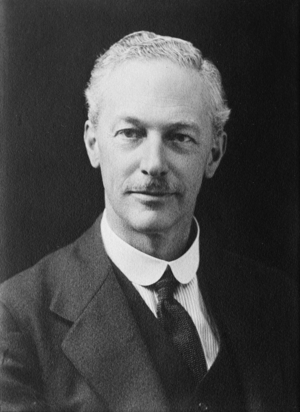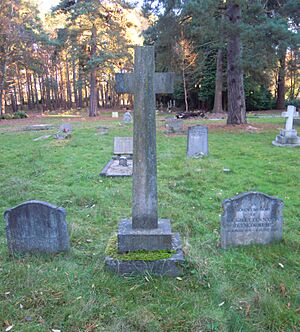Eustace Tennyson d'Eyncourt facts for kids
Quick facts for kids
Sir Eustace Tennyson d'Eyncourt, Bt
|
|
|---|---|
 |
|
| Born | 1 April 1868 Hadley House, Barnet, Hertfordshire
|
| Died | 1 February 1951 (aged 82) Westminster, London
|
| Alma mater | Charterhouse |
| Known for | Director of Naval Construction |
| Spouse(s) | Janet Watson Finlay (married 1898, Anderston, Scotland) |
| Awards | Fellow of the Royal Society |
Sir Eustace Henry William Tennyson d'Eyncourt (born April 1, 1868 – died February 1, 1951) was a very important British naval architect and engineer. He was in charge of designing and building some of the most famous British warships for the Royal Navy from 1912 to 1924. He also led the team that created the first military tanks used in war.
Contents
Early Life and Family
Eustace d'Eyncourt was born in April 1868 in Barnet, Hertfordshire. He was the sixth child in his family. His father was Louis Charles Tennyson d'Eyncourt. Eustace was a cousin of the famous poet, Alfred, Lord Tennyson.
He went to Charterhouse School. After school, he became an apprentice at a shipyard called Armstrong, Whitworth & Co. There, he learned how to design ships. In 1898, he worked as a naval architect in Glasgow, Scotland. He married Janet Burns that same year. They had two children, Gervais and Cecily.
Eustace d'Eyncourt received many awards for his work. In 1921, he became a Fellow of the Royal Society. In 1930, he was made a baronet, which is a special honour.
Designing Warships and Tanks
When Eustace d'Eyncourt was an apprentice, he helped design warships for many different countries. These included Austria, Italy, and Turkey. In 1912, he became the Director of Naval Construction for the Royal Navy. This meant he was in charge of all warship designs. He developed new ways to build ships that could better protect them from torpedo attacks.
One of his most famous contributions was during World War I. In 1915, Winston Churchill asked him to lead a special group. This group was called the Landship Committee. Their job was to design a new vehicle. This vehicle needed to cross dangerous battlefields and fight enemy machine guns. The amazing machine they developed was given the name "tank".
Eustace d'Eyncourt left the Admiralty in 1924. He went back to work for Armstrong, Whitworth & Co. Later, he joined the board of Parsons Marine Steam Turbine Company. He retired in 1948 and passed away in London in 1951. He is buried in Brookwood Cemetery.
Ship Design Innovations
Eustace d'Eyncourt created unique designs for his warships. He made the sides of the ship slope inwards. This made the hull very strong. It also helped protect the ship better from enemy shells.
People also thought his ships looked very beautiful. Naval architecture is like art, and his designs were known for their balanced and pleasing appearance. A great example of his elegant designs is the battlecruiser HMS Hood.
Famous Ship Designs
Eustace d'Eyncourt was ultimately responsible for the design of many important ships. Here are some of them:
Battleships and Battlecruisers
- Brazilian battleship, later HMS Agincourt
- Turkish battleship, later HMS Erin
- Chilean battleships, later HMS Canada and HMS Eagle (an aircraft carrier)
- Revenge-class battleships
- Renown-class battlecruisers
- HMS Hood battlecruiser
- Nelson-class battleships
Cruisers
- Arethusa class
- C class (many ships like Caroline, Calliope, Cambrian, Caledon, Ceres, Carlisle)
- Hawkins-class large cruisers
- Danae-class cruisers (like Danae, Dragon, Diomede)
- HMS Enterprise
- HMS Kent
Aircraft Carriers
- HMS Courageous
- HMS Furious
Destroyers
- R and S-class destroyers
- V and W-class destroyers
- Scott-class flotilla leaders
Submarines
- J class
- K class
Other Vessels
He also oversaw the design of many other types of ships. These included monitors, patrol boats, minesweepers, and sloops. He also worked on converting merchant ships into seaplane carriers.
Tanks
As chairman of the Landship Committee, Eustace d'Eyncourt played a key role. He helped create Britain's first military tanks during World War I.
His Writings
Eustace d'Eyncourt wrote about his work during World War I. He published an article called "Naval Construction During the War." He also wrote an autobiography about his life as a shipbuilder. It was titled A Shipbuilder's Yarn.
| Baronetage of the United Kingdom | ||
|---|---|---|
| New creation | Baronet (of Carter's Corner Farm) 1930–1951 |
Succeeded by Gervais Tennyson d'Eyncourt |


